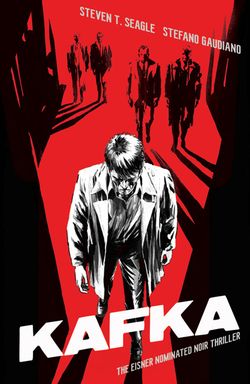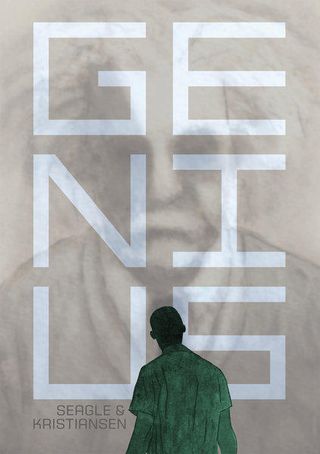The Altadena writer works in comics, cartoons, graphic novels, theater, and more -- almost a superhero himself
by Timothy Rutt
You would like Steven T. Seagle’s job. He takes meetings with the likes of actor/director Kenneth Branagh (“Hamlet” and “Thor”) and Marvel Comics’ Stan Lee. He writes edgy, experimental fiction.
Your kids would like his life, too: He spends his days with Spider-Man and the X-Men. Cartoon superhero BEN10 does whatever Seagle wants him to.
The Altadena resident is an award-winning comics creator, author of graphic novels for grown-ups, the frequent comic book series, and is one of the minds behind many of today’s best animated cartoons.
Not bad for a guy who grew up hating comic books.
 "Do it or shut up about it"
"Do it or shut up about it"
A military brat, Siegel grew up in Colorado Springs. “My friend in Colorado, Eric Koppisch, was a huge comic book fan, and I hated comic books, but I had to walk with him to Safeway every week to buy his comic books,” Seagle said. “So eventually I just started buying the ones he didn’t -- X-Men and Marvel Premiere -- so I’d have something to talk about during the walk down and back.
“I would just read them and, in my teenage hubris, thought they were stupid,” Seagle said. He frequently complained, “It’s a dumb story, I could have written this story -- and after seven or eight years of that, Eric said ‘you should probably just do it or shut up about it.’”
So, as a student at the University of Colorado in Boulder, Seagle, with an artist friend, made a cold submission to Canadian comics company Renegade Press for a six issue series. Publisher Deni Loubert was intrigued, but didn’t like the original artwork, and after much sturm und drang another CU Boulder student, Stefano Gaudiano, seemed to make the perfect artistic fit.
Origin story
Because of the printing press window, they had to work fast: they had five weeks to submit printable art for the first issue, and then another issue every 30 days after that. All through late 1987 and early 1988, along with classes, papers, and exams, they ground out six issues of the comic book they named Kafka from their dorm rooms.
According to the endnotes in the hardback collected Kafka, it was a production line: Seagle would script, Gaudiano pencil, back to Siegel for lettering, then Gaudiano for inking. Siegel and his girlfriend (now wife) Liesel Reinhart would paste up text pages as Gaudiano would paint covers, then off to the plant in Windsor, Ontario.
The comics -- a sparse, noir spy tale of six days in the life of Dan Hutton, one issue for each day -- became an immediate hit among the comics congnescenti. First-timers Seagle and Gaudiano were nominated for an Eisner Award, one of comicdom’s top honors, losing to Alan Moore and Dave Gibbons’ now legendary Watchmen (“I voted for Watchmen,” Seagle said).
Amazingly, after such a stunning debut, Seagle quit comics and went on to graduate school and teaching. He was teaching speech and rhetoric at Pasadena City College and Mt. San Antonio College when another friend, who was in the comics industry, persuaded him to go to the publishers in New York and pitch ideas. He came back with assignments, and then got more assignments, and eventually teaching went back on the shelf.
 A life in panels
A life in panels
Seagle has written comics for every major publisher: DC, Marvel, Image, Vertigo, Dark Horse, and many independent presses. He helmed the comic adaptations of the films Sleepy Hollow and Constantine. He’s been nominated multiple times for Eisner Awards, and received nominations for GLAAD Media Awards for his series American Virgin.
Currently, his graphic novel Genius, illustrated by Teddy H. Kristiansen, is getting rave reviews. Genius is the story of a young physicist working in a Caltech-like place, whose career seems stalled unless he can make another breakthrough -- and he has a lead on a breakthrough made but kept quiet by Einstein himself.
The book is semi-autobiograpical, Seagle says: at one point he and Liesel were visiting his wife’s grandfather Max in Colorado. ‘He lived in Grand Junction, a very unassuming guy ... a government guy.” But Liesel mentioned that Max knew a secret about something big -- whch Seagle won’t elaborate on -- and “I tried to coax the secret out of him before he took it to the grave.
“If you knew that Lincoln wasn’t assasinated by John Wilkes Booth and knew who did it, one of those kind of things. I started thinking that, maybe he’s doing everybody a favor. It was so big, it was the kind of thing you din’t want to know, and didn’t want anybody else to know. And the Genius book is kind of about that.”
Tales of the Unexpected
Seagle says that, in his printed work, he likes the graphic novel form, because it can be complete and more experimental. The Red Book/The Re(a)d Book is another collaboration, where the Danish Kristiansen gave Seagle one of his already-completed Danish books and the charge to write a story within the existing illustrations. As published in the U.S., the book uses Seagle’s text -- but flip it over and read from the back, and it’s the same illustrations telling a different story, translated from Danish. “It was interesting that you could use the same images in two totally different ways,” Seagle said.
Their current collaboration, Mercury, is still underway and is “weirder,” Seagle said. “Teddy had an idea for a new book, and I said don’t tell me the idea, just draw it.” The illustrations are being sent to Seagle out of sequence, and he will write the text based on the illustrations with no idea what story Kristiansen is telling. So will the final edition be Kristiansen’s story or Seagle’s? “We’re just going to do the one, and neither of us knows what it’s about -- chance will decide,” Seagle said.
But Seagle isn’t just writing comic books. About 12 years ago, he formed a comic think tank/collaborative collective with fellow comic creators Duncan Roleau, Joe Casey, and Joe Kelly, called Man of Action Studios.
Men of action
“Man of Action came about because I met the other three guys, all comic book guys who worked for X-Men at the same time for Marvel,” Seagle said. “Marvel was bankrupt at the time. Over time we all migrated to the Superman franchise at DC, and that was also a nightmare because the Superman movie to be directed by Brett Ratner was kind of collapsing before production, and we couldn’t do anything with that character.”
(Seagle wrote It’s a bird ... in 2004, a semi-autobiographical graphic novel illustrated by Kristiansen that explores the deeper meanings of Superman).
Eventually, the four creators felt, “What if we were a company that just made stuff up, but just for us?” Seagle said.
Man of Action Studios was born, and quickly went to work creating an "X-Men Legends" game for Activision. They managed to garner a meeting with Cartoon Network where, Seagle said, they pitched 20 shows in 20 minutes ... and he says, at minute eight, they pitched BEN10.
The cartoon -- about a boy with a device that can turn him into ten different alien superheros -- is now a “$3 billion global thing,” Seagle says. Every two years they rebrand it -- new device, new passel of heros -- “to attract a new group and tell the older group, hey, this is going somewhere.” Man of Action also creates Marvel superhero cartoons for the network, “because we love Marvel characters.”
Young sidekicks
Seagle has no children himself, but thinks the animated cartoons are an important part of his work. “I think comic books wrote themselves out of kids -- they’re too mature, they’re too violent to attract the kids at this point. I wouldn’t give ‘em to my kids.
“The trick is not to write down to kids, because kids are smarter than you give them credit for, most of the time. They want interesting characers, they want stories that mean something to them. We spend a lot of time talking about themes and events that are central to kids, but at the same time there are network standards and practices for what you can or can’t show.
“I try to make sure, when I’m at a convention or something, that I talk to kids -- and I talk to my friends’ kids. The main thing is just write in their terms, and not write it down [to their age] ... I have a rabid fan base of kids who can’t drive.”
Up, up, and away
Seagle and Reinhart moved to Altadena several years ago. “Most of my work is in Hollywood, and Liesel works at Mt. SAC (where she coaches speech and debate), and we didn’t want to move any further east than Pasadena.”
And one day they were driving up Lake Avenue -- and just kept driving.
Altadena reminds them of their life in Colorado, he said. “We need a mountain to look at every day ... We like Altadena, it’s Pasadena without rules. It’s like Boulder, which is very hippie. It’s got that vibe to it, it has a mix of types of people.”
Siegel and Reinhart live in a home that used to belong to Five Acres, and it’s close enough to the mountains that “there’s bears in our yard, racoons in our yard. It’s like a zoo.” Seagle became so involved in the community he was the chair of Altadena Heritage for two years.
Onstage
Siegle and Reinhart also do some work together: they’ve been collaborating on a musical for the past four years that they hope to wrap up soon. They’re also running Speak Theater Arts, a reader’s theatre group. They’ve produced a reader’s theater piece, abbreviated “N. W. C.” (which is actually three racial slurs) with some of her former students that has evolved into “a kind of avant garde theatrical presentation.” It has been performed hundreds of times around the country, and Seagle says, “I’ve seen every show we’ve done. It’s great to see something with an audience when they get it.”
His stage work ends up informing his comic work, he said: he’s “working on something that’s going to be a stage play and a graphic novel at the same time,” Seagle says. His book Genius “felt very stage-like and it dawned on me that I wrote the whole book when I was touring with N.W.C.”
Between the comics, the graphic novels, the cartoons, and the stage shows, there’s a lot on Seagle’s plate, but soon there may be more. Seagle is working with Kenneth Branagh on a proposed dramatization of Kafka. “We’ve been working on it three years,” Seagle said, each bringing their strengths to the project: “He sits in his wheelhouse, I sit in my wheelhouse, and now we’re talking to the studios.” Seagle says that they may be able to announce something about that project soon -- opening yet another outlet for his endlessly creative mind.





